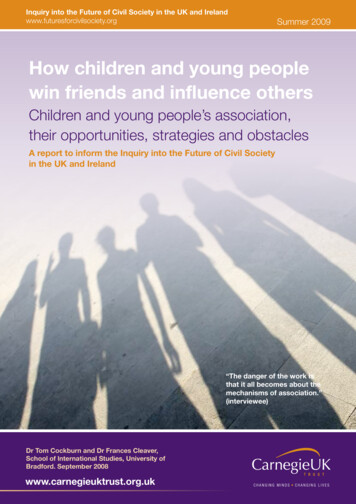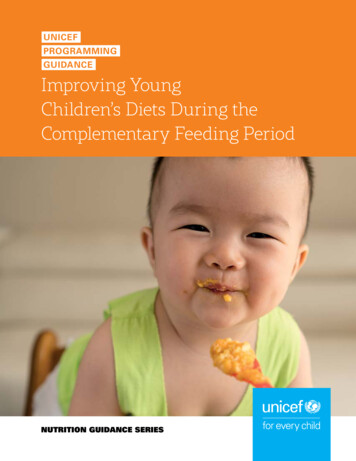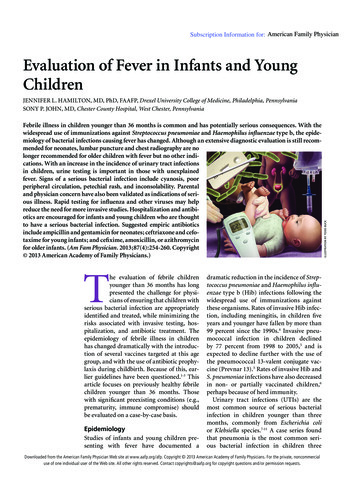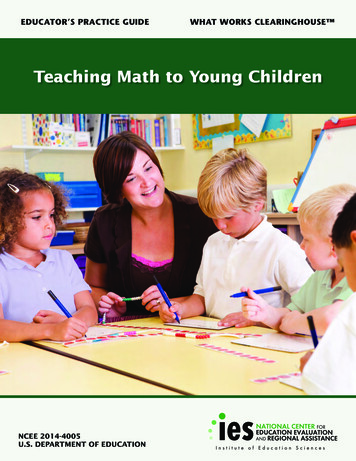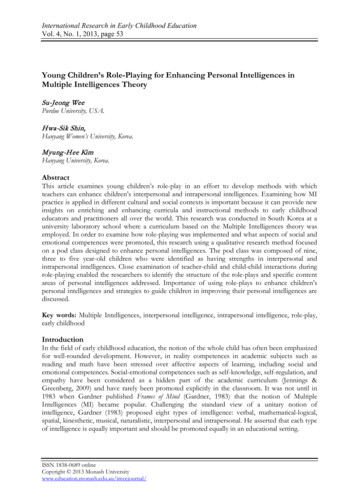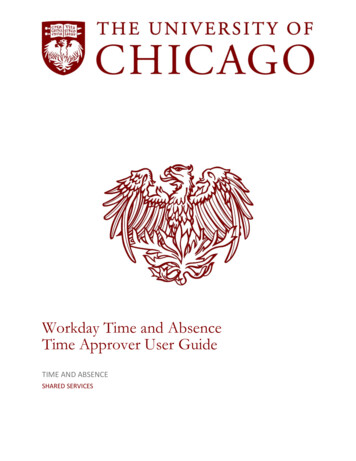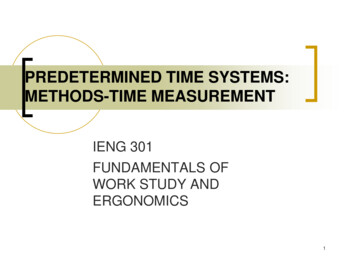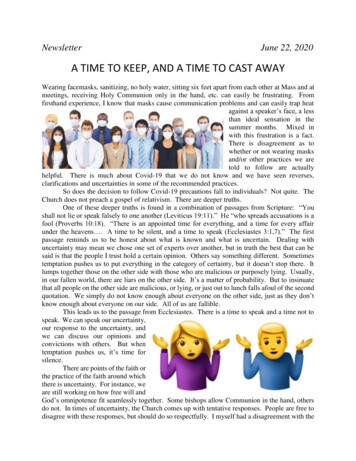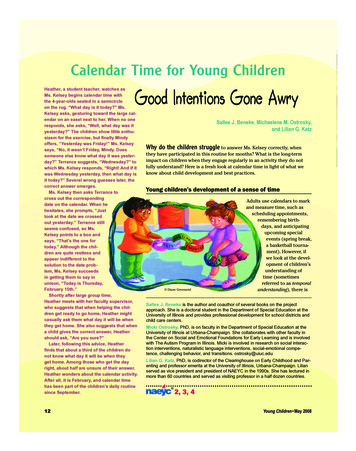
Transcription
Calendar Time for Young ChildrenGood Intentions Gone AwryHeather, a student teacher, watches asMs. Kelsey begins calendar time withthe 4-year-olds seated in a semicircleon the rug. “What day is it today?” Ms.Kelsey asks, gesturing toward the large calendar on an easel next to her. When no oneresponds, she asks, “Well, what day was ityesterday?” The children show little enthusiasm for the exercise, but finally Mindyoffers, “Yesterday was Friday!” Ms. Kelseysays, “No, it wasn’t Friday, Mindy. Doessomeone else know what day it was yesterday?” Terrance suggests, “Wednesday?” towhich Ms. Kelsey responds, “Right! And if itwas Wednesday yesterday, then what day isit today?” Several wrong guesses later, thecorrect answer emerges.Ms. Kelsey then asks Terrance tocross out the correspondingdate on the calendar. When hehesitates, she prompts, “Justlook at the date we crossedout yesterday.” Terrance stillseems confused, so Ms.Kelsey points to a box andsays, “That’s the one fortoday.” Although the children are quite restless andappear indifferent to thesolution to the date problem, Ms. Kelsey succeedsin getting them to say inunison, “Today is Thursday,February 15th.”Shortly after large group time,Heather meets with her faculty supervisor,who suggests that when helping the children get ready to go home, Heather mightcasually ask them what day it will be whenthey get home. She also suggests that whena child gives the correct answer, Heathershould ask, “Are you sure?”Later, following this advice, Heatherfinds that about a third of the children donot know what day it will be when theyget home. Among those who get the dayright, about half are unsure of their answer.Heather wonders about the calendar activity.After all, it is February, and calendar timehas been part of the children’s daily routinesince September.12YCBeneke.indd 1Sallee J. Beneke, Michaelene M. Ostrosky,and Lilian G. KatzWhy do the children struggle to answer Ms. Kelsey correctly, whenthey have participated in this routine for months? What is the long-termimpact on children when they engage regularly in an activity they do notfully understand? Here is a fresh look at calendar time in light of what weknow about child development and best practices.Young children’s development of a sense of time Diane GreenseidAdults use calendars to markand measure time, such asscheduling appointments,remembering birthdays, and anticipatingupcoming specialevents (spring break,a basketball tournament). However, ifwe look at the development of children’sunderstanding oftime (sometimesreferred to as temporalunderstanding), there isSallee J. Beneke is the author and coauthor of several books on the projectapproach. She is a doctoral student in the Department of Special Education at theUniversity of Illinois and provides professional development for school districts andchild care centers.Micki Ostrosky, PhD, is on faculty in the Department of Special Education at theUniversity of Illinois at Urbana-Champaign. She collaborates with other faculty inthe Center on Social and Emotional Foundations for Early Learning and is involvedwith The Autism Program in Illinois. Micki is involved in research on social interaction interventions, naturalistic language interventions, social-emotional competence, challenging behavior, and transitions. ostrosky@uiuc.eduLilian G. Katz, PhD, is codirector of the Clearinghouse on Early Childhood and Parenting and professor emerita at the University of Illinois, Urbana-Champaign. Lilianserved as vice president and president of NAEYC in the 1990s. She has lectured inmore than 60 countries and served as visiting professor in a half dozen countries. 2, 3, 4Young Children May 20084/17/2008 3:48:33 PM
Richard Graessle/ NAEYClittle evidence that calendar activities that mark extendedperiods of time (a month, a week) are meaningful for children below first grade (Friedman 2000). However, there aresome temporal concepts that preschoolers can grasp inthe context of their daily activities—concepts such as later,before, and after.Barriers to meaningful participationTo participate meaningfully in calendar activities, youngchildren must understand that time is sequential. Thesequences include yesterday, today, and tomorrow; morning, afternoon, and evening; Sunday, Monday, Tuesday,and so on. Children also must be able to conceptualizebefore and after and think about future and past events.Three-year-olds typically “have established object permanence and can recall past events, even though they do notunderstand the meaning of the words ‘yesterday,’ ‘today,’or ‘tomorrow’” (CTB/McGraw-Hill 2002, 9). Thus, youngchildren can talk about things that have happened or willhappen, but they cannot yet understand or talk about theseevents in terms of units of time (days, weeks) or sequence.This child development knowledge draws into question theusefulness of calendar activities for children under age 6.this event any differently than if he were told it isin eight days. In fact, it is difficult for preschoolersto judge length of time within a given day (withhours as the unit of time), such as “in two hours”versus “in four hours.” Perhaps this is the reasonchildren on a car trip repeatedly ask, “How longuntil we get there?”According to Friedman (2000), the ability tojudge the relative time from a past event or untila future event in terms of the calendar year is notin place until sometime between 7 and 10 yearsof age. The following anecdote about 6-year-olds’attempts to understand time concepts associatedwith birthdays and age illustrate Friedman’s point.As Joey’s grandparents arrive for his birthday,Joey runs to greet them, saying, “I can’t believeI’m gonna be 6.” “So, you’re going to be 6. Sixwhat?” his grandmother asks. Joey responds,“It’s my birthday. I’m gonna be 6.” “Yes, I know,”she replies, “but six what? You’re not six books.”At that point Joey’s 9-year-old brother whispers in his ear,“You’re gonna be 6 years old, dummy!” and Joey says,“I’m gonna be 6 years old.”Three days later, as Joey’s friends assemble for the traditional noisy birthday party, a discussion begins about whois already 6 and who is not. Marta states, “Well, I’m 6½.”Joey asks her, “Six-and-a-half what?” Marta responds,“I don’t know.” Another child says to 6½-year-old Marta,“Wait a minute. When were you a baby?” She hesitates andthen answers, “I don’t know, maybe 10 years ago.”True understanding of dates and the calendar comes withmaturity. Given the above information on the level of thinking required to grasp the time concepts of the calendar andthe developmental abilities of young children, teachers maywant to reconsider the calendar routine and their expectations for young children’s comprehension.Teaching using the calendar—or not?Early childhood educators may use the calendar to teachconcepts other than time, including numeracy, vocabulary(month, year, weekend), sequencing (yesterday, today,tomorrow), and patterning (Monday, Tuesday, Wednesday).Additionally, as children attend to the visual calendar,Distance in timeCalendar use requires children to understand not onlyconcepts such as before and after but also the relativelengths of time or distance of past or future events fromthe present (Friedman 2000). For example, how far away isOctober 30 when today is October 5? How long is the weekend? Preschoolers cannot usually judge such distances orlengths of time. A 4-year-old who learns that there will be afield trip in five days will not judge the temporal distance ofYoung Children May 2008YCBeneke.indd 2Young children can talk about thingsthat have happened or will happen,but they cannot yet understand or talkabout these events in terms of units oftime or sequence.134/17/2008 3:48:34 PM
teachers may hope they will learn numeral recognitionand one-to-one correspondence. Early childhood specialists have cited numbers, spatial reasoning, patterning,logical relations, measurement, and early algebra as keycomponents of young children’s mathematical growth(for example, Greenes 1999; NCTM 2000). However, most4-year-olds are not ready to grasp the complex conceptsinvolved in dates (Etheridge & King 2005).Math conceptsLearning experiences that center on mathematical concepts should not only be enjoyable and meaningful but alsodirect children’s thinking toward, and focus it on, importantmathematical ideas (Trafton, Reys, & Wasman 2001). Givingpreschool children opportunities to explore and experiment individually with math concepts, using concrete materials with a responsive adult to question and guide learning,is likely to be more meaningful and beneficial than havingyoung children participate in a whole group discussion ofsuch concepts centered on the calendar.For example, a teacher can help children notice patternsin the environment and in their work and explain the process of patterning both at circle time and individually. Ateacher might join a child who is stringing beads and say,“I think I will make a pattern with my beads. My pattern isblue, yellow, red; blue, yellow, red. What kind of pattern canyou make with your beads?” These approaches can helpchildren build their own patterning abilities.Other knowledge and skillsMany teachers use calendar time to teach skills unrelated to math, such as colors, letters, emergent writing,and social skills. While each of these concepts and skills isimportant for young children to learn, the calendar routineA poster with illustrations or photos ofthe day’s activities in sequence can behelpful for all young children.is not the most useful format for teaching them. For example, it is difficult for teachers to individualize instructionto meet the diverse needs of young learners during a largegroup activity such as calendar time.Better alternatives at group timeIf focusing on the calendar is not an appropriate way tointroduce young children to time concepts, numeracy, andthe other concepts mentioned above, then what are somebetter ways?The following evidence-based practices are likely to bemore effective than calendar activities in presenting timeconcepts to young children.Picture schedulesAlthough young children have difficulty judging thelength of time between events (for example, how longthe time between snack and outside play will be), theycan understand a sequence of events (for example, snackcomes after circle time). Young children generally have astrong sense of narrative and the way a story progresses.Pictures illustrating the schedule of class activities areoften recommended for children with particular disabilities.Similarly, a poster with illustrations or photos of the day’sactivities in sequence can be helpful for all young children. Elisabeth NicholsClassroom journal14YCBeneke.indd 3Using a digital camera, the teachercan take frequent photographs ofclassroom events, projects, or fieldtrips, then invite the children tohelp select photos for a classroomjournal. Attach the photos to a datedpage (one photo per page or multiplephotos on a page) or tuck them intoa plastic sleeve. Post or display themin a designated place—on a wall orbulletin board or in a binder—toclearly reflect the sequence of activities: “On Tuesday, we went to thepark, we made pancakes, and we readPancakes, Pancakes! by Eric Carle.”As the children add new picturesYoung Children May 20084/17/2008 3:48:34 PM
Gameschronicling recent events, they can revisit and discuss pastshared events.Along these same lines, the teacher can collect samplesof children’s work in a notebook as a visual record ofshared events. Children can take turns contributing work tothis community notebook. When teachers encourage children to tell peers or their families the story of their project,the children strengthen their understanding of the way anevent unfolds, with the various activities taking place in atime sequence.Games are another way for children to begin to get a feelfor the length of various units of time and the vocabularyassociated with them. For example, children might guesshow many seconds it takes to walk from one side of theplayground to the other, and the teacher or another childcan time it with a watch. Or a teacher might ask the children to guess how many minutes it will take for a snowballto melt indoors and then time it with a clock. They mightguess how many hours it will be until story time, tally thehours as they pass, and then compare the result with theirestimate. These experiences with units of time (seconds,minutes, hours) can lead to discussions about points intime during the school day and the relative distance in thefuture of these points in time. For example, the teachermight say, “We are going to the library at nine o’clock, andwe will go outside at ten o’clock. Where are we going first?”Richard Graessle/ NAEYCProject workDocumentation displaysDisplaying documentation of shared class events canlead to meaningful discussions that involve time-linkedvocabulary. For example, when looking at a documentation display about the class construction of a giant papiermâché butterfly, one child said, “See, there’s the butterflywe made that other time.” Her teacher responded, “Yes, wemade the giant butterfly two weeks ago. Here [pointing toa photograph on the display] is a picture of the frame webuilt the first day, and the picture next to it shows you adding the papier-mâché on the second day.”Linear representationsLinear representations also can help children begin tounderstand and conceptualize that a day is a unit of timeand talk about it with increasing clarity. For example, tocount the number of days they have been in kindergarten,children can add a link to a paper chain each day, or number a pattern of colored Post-it notes and place them onthe classroom wall, or add a Unifix cube to a stack of cubes.The teacher can emphasize time-linked vocabulary, such asbefore, after, later, earlier, as the children add the new link.Unlike calendars, linear representations do not require theleft-to-right orientation.Y
Adults use calendars to mark and measure time, such as scheduling appointments, remembering birth-days, and anticipating upcoming special events (spring break, a basketball tourna-ment). However, if we look at the devel-opment of children’s understanding of time (sometimes referred to as temporal understanding), there is
